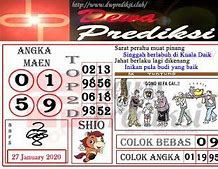
Legendary History of the Fortune Cookie #5
The latest history of the fortune cookie is that it originated in Japan. A wood block image from 1878 shows what seems to be a Japanese street vendor grilling, fortune cookies. They can still be found in certain districts of Kyoto Japan, but are larger and darker than the fortune cookie we are familiar with. They are made with miso paste or sesame and have a savory flavor instead of the sweet, sugar fortune cookie that is readily available in the United States. The fortunes were never put inside the cookies either. Instead, they were tucked into the fold of the fortune cookie on the outside. This may be the earliest fortune cookie to appear in the classic shape.
Regardless of who was the first inventor, it's probable that all of the above theories have some validity.
Legendary History of the Fortune Cookie #1
The Chinese immigrant, David Jung, who founded the Hong Kong Noodle Company while living in Los Angeles, invented the cookie in 1918. Concerned about the poor people he saw wandering near his shop, he created the cookie and passed them out free on the streets. Each cookie contained a strip of paper with an inspirational Bible scripture on it, written for Jung by a Presbyterian minister.
The Mysterious Origin of the Fortune Cookie
Much to most Americans' surprise, the fortune cookie is not a Chinese invention.
Fortune Cookies Actually Originated in California!
It is actually an American invention originating in California. There are many theories, and much speculation surrounding the mysterious origin of the fortune cookie, regarding in which city the fortune cookie originated and who invented it--Chinese-American, Japanese-American or 14th century revolutionists--there has been much debate. In 1983, there was even a mock trial held in San Francisco's pseudo-legal Court of Historical Review to determine the origins of the fortune cookie.
Legendary History of the Fortune Cookie #3
In the early 1900s a plan was hatched to transform San Francisco's Chinatown from a ghetto into a cute tourist attraction. San Francisco's Chinatown promised tourists a real Oriental experience. The city promoted their Chinese decorations, pageantry and architecture. Supposedly, increased tourism led to the invention of the fortune cookie to fill the void of a dessert item. To fill the tourists' demands for a dessert, a worker in San Francisco's Kay Heong Noodle Factory invented a plain flat cookie in the 1930s. This plain flat cookie, while still warm, was folded around a little piece of paper on which a hand-written prediction or piece of Chinese wisdom would be found.
Japanese Internment Causes a Shift
Flashback: How Japanese Americans Were Forced Into Concentration Camps During WWII
WATCH: How Japanese Americans Were Forced Into Concentration Camps During WWII
How did fortune cookies migrate from Japanese bakeries to Chinese restaurants? American food preferences likely played a part.
Japanese emigres to the U.S. around the turn of the 20th century couldn’t open Japanese restaurants, says Lee, because Americans didn’t want to eat raw fish. “So in many cases, they actually opened Chinese restaurants because they were kind of going through a big renaissance with chop suey, chow mein, egg foo young.” And Americans' expectation for dessert at the end of meals, says Lee, may explain why many of these restaurants began to offer fortune cookies with the check.
But the fortune cookie, once produced by Japanese Americans, eventually wound up in the hands of Chinese American manufacturers during World War II. After the Japanese bombed Pearl Harbor in 1941 and President Franklin D. Roosevelt ordered the relocation and internment of Japanese Americans through his Executive Order 9066, Japanese American businesses began to close, including the bakeries that once made fortune cookies. That gave Chinese American entrepreneurs an opening to produce and sell them.
More than 100 years later, fortune cookies remain a massive business. New York-based Wonton Food, the largest fortune-cookie producer, manufactures more than 4 million of them daily, with an estimated 3 billion cookies produced annually, wrote Lee.
READ MORE: Building the Transcontinental Railroad: How 20,000 Chinese Americans Made it Happen
Fortune Cookie Controversy
A family opening fortune cookies.
As fortune cookies became a staple in Chinese restaurants, they also became fodder for ethnic stereotyping.
Despite having historic roots in Japan and growing into a uniquely American business success story, the cookies became an easy shorthand for all things Chinese—along with other reductive and sometimes disparaging pop-culture stereotypes like squinty eyes, heavy accents and being good at math. In 2012 for example, MSG Network aired a fan sign of the New York Knick’s Taiwanese American basketball sensation Jeremy Lin, overlaying his face above a broken fortune cookie. The same year, ice cream makers Ben & Jerry’s briefly offered a “Taste the Lin-sanity”-themed frozen yogurt, complete with broken fortune cookies, before an outcry forced them to publicly apologize and remove the cookies from the recipe.
Using things like fortune cookies and takeout boxes as shorthands for Chinese culture is misleading, says Lee, given that they’re distinctly American inventions—and the global reach of American culture helps to perpetuate those stereotypes around the world. But despite misconceptions about its true origins and its misuse as a symbol of Chinese heritage, the fortune cookie still carries powerful resonance throughout American culture.
“You have the number of people who have been engaged through fortune cookies, you have fortune cookie little baby booties, fortune cookie jewelry,” says Lee. “It really speaks to Americans in a very profound way.”
READ MORE: The 8-Year-Old Chinese American Girl Who Helped Desegregate Schools—in 1885
Bahasa Latin Dalam Penulisan Resep
While the fortune cookie — a beloved staple in Chinese American dining — is commonly linked to China, the auspicious treat surprisingly traces its roots to a completely different country, according to researchers on the subject.
Those cookies, however, were larger, darker and made with sesame and miso instead of vanilla and butter (as with modern fortune cookies), Lee noted. Meanwhile, the fortunes were pinched in the cookie’s folds instead of being stuffed inside them.
Chinese restaurants also addressed a demand from veterans returning from the Pacific Theater, where they encountered the cookies. The treats were initially sold in California restaurants but quickly spread in many Chinese establishments across the country, with some 250 million cookies being made each year by the late 1950s.
Since then, modern fortune cookies have been a distinctly American treat. A video Lee had posted in 2008 shows
being absolutely clueless about them.
“What is this?” many asked. At least one was surprised by the written fortune inside.
Today, Brooklyn-based Wonton Food Inc. is the world’s biggest producer of fortune cookies. The company, which also
facilities in Houston and Nashville, churns out
per day, or a whopping 1.6 billion cookies each year.
“You have the number of people who have been engaged through fortune cookies, you have fortune cookie little baby booties, fortune cookie jewelry,” Lee
. “It really speaks to Americans in a very profound way.”
PK ! Í\! 0 [Content_Types].xml ¢( ̘]oÓ0†ï‘ø‘oQãºÀ¨é.ø¸âcã˜ä´58¶e»eı÷œ$İT¦’nxÖá&’c¿çÊ�İÄı"y>†!ö¿2åù:Ò˜òiLyª‹4¦<åFS�ú#�)OA’Æ”§BIcÊS²¤1eÚâ%BQ99Êû?/¯‡‡3Ü«vê‰Ã@à£ÿŸİfÄĞÉ“†îĶ�æHnŞŸw/~ ÿÿ PK ! £ì‚& â _rels/.rels ¢( ¬’ÏJ1‡ï‚ïæŞÍ¶Šˆ4Û‹½‰¬0&³»©›?$SißŞØƒº°Á3ó›�o’¬77ŠJÙ¯`YÕ Èë`¬ï¼¶O‹{™Ñƒ'GÊ°i®¯Ö/4"—¡<ؘE¡ø¬``�Rf=�Ã\…H¾tº�r9¦^FÔïØ“\Õõ�L¿ĞL˜bk¤¹Ñ#ı�-1d”:$ZÄT¦Û²‹h1õÄ
LĞÏ¥œO‰ª�AÎİş](t�ÕôôŞ‘ç9/:0yCæ¼ÆxÎhyI£iâG&F–1Q.ÅSúœĞê²oÆÃŞ½y´ãÌÕ|÷ª]¤şKHN~fó ÿÿ PK ! Kõ=ì½ 7 ppt/slides/_rels/slide7.xml.relsŒÏ½
Â0ğ]ğÂí&ÕADšºˆ 8‰>À‘\Û`›„\ûöf´ààx_¿?WŞã ^”دa-+äM°Îwî·Ój‚3z‹Cğ¤a"†C³\ÔW0—#î]dQÏúœã^)6=�È2DòeÒ†4b.eêTDóÀ�Ô¦ª¶*}ĞÌLq¶ÒÙ®AܦHÿØ¡m�¡c0Ï‘|ş¡xp–.8…g.,¦�²)¿û³¥�, šZÍŞm> ÿÿ PK ! Kõ=ì½ 7 ppt/slides/_rels/slide8.xml.relsŒÏ½
Â0ğ]ğÂí&ÕADšºˆ 8‰>À‘\Û`›„\ûöf´ààx_¿?WŞã ^”دa-+äM°Îwî·Ój‚3z‹Cğ¤a"†C³\ÔW0—#î]dQÏúœã^)6=�È2DòeÒ†4b.eêTDóÀ�Ô¦ª¶*}ĞÌLq¶ÒÙ®AܦHÿØ¡m�¡c0Ï‘|ş¡xp–.8…g.,¦�²)¿û³¥�, šZÍŞm> ÿÿ PK ! Kõ=ì½ 7 ppt/slides/_rels/slide9.xml.relsŒÏ½
Â0ğ]ğÂí&ÕADšºˆ 8‰>À‘\Û`›„\ûöf´ààx_¿?WŞã ^”دa-+äM°Îwî·Ój‚3z‹Cğ¤a"†C³\ÔW0—#î]dQÏúœã^)6=�È2DòeÒ†4b.eêTDóÀ�Ô¦ª¶*}ĞÌLq¶ÒÙ®AܦHÿØ¡m�¡c0Ï‘|ş¡xp–.8…g.,¦�²)¿û³¥�, šZÍŞm> ÿÿ PK ! Kõ=ì½ 7 ! ppt/slides/_rels/slide10.xml.relsŒÏ½
Â0ğ]ğÂí&ÕADšºˆ 8‰>À‘\Û`›„\ûöf´ààx_¿?WŞã ^”دa-+äM°Îwî·Ój‚3z‹Cğ¤a"†C³\ÔW0—#î]dQÏúœã^)6=�È2DòeÒ†4b.eêTDóÀ�Ô¦ª¶*}ĞÌLq¶ÒÙ®AܦHÿØ¡m�¡c0Ï‘|ş¡xp–.8…g.,¦�²)¿û³¥�, šZÍŞm> ÿÿ PK ! Kõ=ì½ 7 ppt/slides/_rels/slide6.xml.relsŒÏ½
Â0ğ]ğÂí&ÕADšºˆ 8‰>À‘\Û`›„\ûöf´ààx_¿?WŞã ^”دa-+äM°Îwî·Ój‚3z‹Cğ¤a"†C³\ÔW0—#î]dQÏúœã^)6=�È2DòeÒ†4b.eêTDóÀ�Ô¦ª¶*}ĞÌLq¶ÒÙ®AܦHÿØ¡m�¡c0Ï‘|ş¡xp–.8…g.,¦�²)¿û³¥�, šZÍŞm> ÿÿ PK ! Kõ=ì½ 7 ppt/slides/_rels/slide5.xml.relsŒÏ½
Â0ğ]ğÂí&ÕADšºˆ 8‰>À‘\Û`›„\ûöf´ààx_¿?WŞã ^”دa-+äM°Îwî·Ój‚3z‹Cğ¤a"†C³\ÔW0—#î]dQÏúœã^)6=�È2DòeÒ†4b.eêTDóÀ�Ô¦ª¶*}ĞÌLq¶ÒÙ®AܦHÿØ¡m�¡c0Ï‘|ş¡xp–.8…g.,¦�²)¿û³¥�, šZÍŞm> ÿÿ PK ! Kõ=ì½ 7 ppt/slides/_rels/slide4.xml.relsŒÏ½
Â0ğ]ğÂí&ÕADšºˆ 8‰>À‘\Û`›„\ûöf´ààx_¿?WŞã ^”دa-+äM°Îwî·Ój‚3z‹Cğ¤a"†C³\ÔW0—#î]dQÏúœã^)6=�È2DòeÒ†4b.eêTDóÀ�Ô¦ª¶*}ĞÌLq¶ÒÙ®AܦHÿØ¡m�¡c0Ï‘|ş¡xp–.8…g.,¦�²)¿û³¥�, šZÍŞm> ÿÿ PK ! Kõ=ì½ 7 ppt/slides/_rels/slide3.xml.relsŒÏ½
Â0ğ]ğÂí&ÕADšºˆ 8‰>À‘\Û`›„\ûöf´ààx_¿?WŞã ^”دa-+äM°Îwî·Ój‚3z‹Cğ¤a"†C³\ÔW0—#î]dQÏúœã^)6=�È2DòeÒ†4b.eêTDóÀ�Ô¦ª¶*}ĞÌLq¶ÒÙ®AܦHÿØ¡m�¡c0Ï‘|ş¡xp–.8…g.,¦�²)¿û³¥�, šZÍŞm> ÿÿ PK ! Kõ=ì½ 7 ppt/slides/_rels/slide2.xml.relsŒÏ½
Â0ğ]ğÂí&ÕADšºˆ 8‰>À‘\Û`›„\ûöf´ààx_¿?WŞã ^”دa-+äM°Îwî·Ój‚3z‹Cğ¤a"†C³\ÔW0—#î]dQÏúœã^)6=�È2DòeÒ†4b.eêTDóÀ�Ô¦ª¶*}ĞÌLq¶ÒÙ®AܦHÿØ¡m�¡c0Ï‘|ş¡xp–.8…g.,¦�²)¿û³¥�, šZÍŞm> ÿÿ PK ! c\#´À 7 ppt/slides/_rels/slide1.xml.relsŒÏ½jÃ0ğ=Ğw·W²;„,e)C§�>À!�mQ[:¹Äo�1tÈx_¿?×]îË,ş(³�AC+lt>Œ~n_ï'\08œc
1\ÌÛ¡»ÒŒ¥ñ䋪Ö0•’ÎJ±�hA–1Q¨“!æK-ó¨Ú_I}4ÍQågÌνÓ�{ׂ¸m‰^±ã0xKŸÑ®…òO„âÙ;úÆ-®¥²˜G*¤|îï–ZY#@™NíŞ5 ÿÿ PK ! Kõ=ì½ 7 ! ppt/slides/_rels/slide11.xml.relsŒÏ½
Â0ğ]ğÂí&ÕADšºˆ 8‰>À‘\Û`›„\ûöf´ààx_¿?WŞã ^”دa-+äM°Îwî·Ój‚3z‹Cğ¤a"†C³\ÔW0—#î]dQÏúœã^)6=�È2DòeÒ†4b.eêTDóÀ�Ô¦ª¶*}ĞÌLq¶ÒÙ®AܦHÿØ¡m�¡c0Ï‘|ş¡xp–.8…g.,¦�²)¿û³¥�, šZÍŞm> ÿÿ PK ! Kõ=ì½ 7 ! ppt/slides/_rels/slide12.xml.relsŒÏ½
Â0ğ]ğÂí&ÕADšºˆ 8‰>À‘\Û`›„\ûöf´ààx_¿?WŞã ^”دa-+äM°Îwî·Ój‚3z‹Cğ¤a"†C³\ÔW0—#î]dQÏúœã^)6=�È2DòeÒ†4b.eêTDóÀ�Ô¦ª¶*}ĞÌLq¶ÒÙ®AܦHÿØ¡m�¡c0Ï‘|ş¡xp–.8…g.,¦�²)¿û³¥�, šZÍŞm> ÿÿ PK ! Kõ=ì½ 7 ! ppt/slides/_rels/slide13.xml.relsŒÏ½
Â0ğ]ğÂí&ÕADšºˆ 8‰>À‘\Û`›„\ûöf´ààx_¿?WŞã ^”دa-+äM°Îwî·Ój‚3z‹Cğ¤a"†C³\ÔW0—#î]dQÏúœã^)6=�È2DòeÒ†4b.eêTDóÀ�Ô¦ª¶*}ĞÌLq¶ÒÙ®AܦHÿØ¡m�¡c0Ï‘|ş¡xp–.8…g.,¦�²)¿û³¥�, šZÍŞm> ÿÿ PK ! Kõ=ì½ 7 ! ppt/slides/_rels/slide22.xml.relsŒÏ½
Â0ğ]ğÂí&ÕADšºˆ 8‰>À‘\Û`›„\ûöf´ààx_¿?WŞã ^”دa-+äM°Îwî·Ój‚3z‹Cğ¤a"†C³\ÔW0—#î]dQÏúœã^)6=�È2DòeÒ†4b.eêTDóÀ�Ô¦ª¶*}ĞÌLq¶ÒÙ®AܦHÿØ¡m�¡c0Ï‘|ş¡xp–.8…g.,¦�²)¿û³¥�, šZÍŞm> ÿÿ PK ! Kõ=ì½ 7 ! ppt/slides/_rels/slide21.xml.relsŒÏ½
Â0ğ]ğÂí&ÕADšºˆ 8‰>À‘\Û`›„\ûöf´ààx_¿?WŞã ^”دa-+äM°Îwî·Ój‚3z‹Cğ¤a"†C³\ÔW0—#î]dQÏúœã^)6=�È2DòeÒ†4b.eêTDóÀ�Ô¦ª¶*}ĞÌLq¶ÒÙ®AܦHÿØ¡m�¡c0Ï‘|ş¡xp–.8…g.,¦�²)¿û³¥�, šZÍŞm> ÿÿ PK ! Kõ=ì½ 7 ! ppt/slides/_rels/slide20.xml.relsŒÏ½
Â0ğ]ğÂí&ÕADšºˆ 8‰>À‘\Û`›„\ûöf´ààx_¿?WŞã ^”دa-+äM°Îwî·Ój‚3z‹Cğ¤a"†C³\ÔW0—#î]dQÏúœã^)6=�È2DòeÒ†4b.eêTDóÀ�Ô¦ª¶*}ĞÌLq¶ÒÙ®AܦHÿØ¡m�¡c0Ï‘|ş¡xp–.8…g.,¦�²)¿û³¥�, šZÍŞm> ÿÿ PK ! Kõ=ì½ 7 ! ppt/slides/_rels/slide19.xml.relsŒÏ½
Â0ğ]ğÂí&ÕADšºˆ 8‰>À‘\Û`›„\ûöf´ààx_¿?WŞã ^”دa-+äM°Îwî·Ój‚3z‹Cğ¤a"†C³\ÔW0—#î]dQÏúœã^)6=�È2DòeÒ†4b.eêTDóÀ�Ô¦ª¶*}ĞÌLq¶ÒÙ®AܦHÿØ¡m�¡c0Ï‘|ş¡xp–.8…g.,¦�²)¿û³¥�, šZÍŞm> ÿÿ PK ! Kõ=ì½ 7 ! ppt/slides/_rels/slide18.xml.relsŒÏ½
Â0ğ]ğÂí&ÕADšºˆ 8‰>À‘\Û`›„\ûöf´ààx_¿?WŞã ^”دa-+äM°Îwî·Ój‚3z‹Cğ¤a"†C³\ÔW0—#î]dQÏúœã^)6=�È2DòeÒ†4b.eêTDóÀ�Ô¦ª¶*}ĞÌLq¶ÒÙ®AܦHÿØ¡m�¡c0Ï‘|ş¡xp–.8…g.,¦�²)¿û³¥�, šZÍŞm> ÿÿ PK ! Kõ=ì½ 7 ! ppt/slides/_rels/slide17.xml.relsŒÏ½
Â0ğ]ğÂí&ÕADšºˆ 8‰>À‘\Û`›„\ûöf´ààx_¿?WŞã ^”دa-+äM°Îwî·Ój‚3z‹Cğ¤a"†C³\ÔW0—#î]dQÏúœã^)6=�È2DòeÒ†4b.eêTDóÀ�Ô¦ª¶*}ĞÌLq¶ÒÙ®AܦHÿØ¡m�¡c0Ï‘|ş¡xp–.8…g.,¦�²)¿û³¥�, šZÍŞm> ÿÿ PK ! Kõ=ì½ 7 ! ppt/slides/_rels/slide16.xml.relsŒÏ½
Â0ğ]ğÂí&ÕADšºˆ 8‰>À‘\Û`›„\ûöf´ààx_¿?WŞã ^”دa-+äM°Îwî·Ój‚3z‹Cğ¤a"†C³\ÔW0—#î]dQÏúœã^)6=�È2DòeÒ†4b.eêTDóÀ�Ô¦ª¶*}ĞÌLq¶ÒÙ®AܦHÿØ¡m�¡c0Ï‘|ş¡xp–.8…g.,¦�²)¿û³¥�, šZÍŞm> ÿÿ PK ! Kõ=ì½ 7 ! ppt/slides/_rels/slide15.xml.relsŒÏ½
Â0ğ]ğÂí&ÕADšºˆ 8‰>À‘\Û`›„\ûöf´ààx_¿?WŞã ^”دa-+äM°Îwî·Ój‚3z‹Cğ¤a"†C³\ÔW0—#î]dQÏúœã^)6=�È2DòeÒ†4b.eêTDóÀ�Ô¦ª¶*}ĞÌLq¶ÒÙ®AܦHÿØ¡m�¡c0Ï‘|ş¡xp–.8…g.,¦�²)¿û³¥�, šZÍŞm> ÿÿ PK ! Kõ=ì½ 7 ! ppt/slides/_rels/slide14.xml.relsŒÏ½
Â0ğ]ğÂí&ÕADšºˆ 8‰>À‘\Û`›„\ûöf´ààx_¿?WŞã ^”دa-+äM°Îwî·Ój‚3z‹Cğ¤a"†C³\ÔW0—#î]dQÏúœã^)6=�È2DòeÒ†4b.eêTDóÀ�Ô¦ª¶*}ĞÌLq¶ÒÙ®AܦHÿØ¡m�¡c0Ï‘|ş¡xp–.8…g.,¦�²)¿û³¥�, šZÍŞm> ÿÿ PK ! ¤v#yŠ Ø ppt/_rels/presentation.xml.rels ¢( ¼—ßjƒ0‡ï{ÉıŒ±ÿGµ7cĞ‹ÁغÈôÔÊ4‘$ëÖ·_h‡ØR½çòü4Ç�?“åê·m¢=[k•1',Uè²VUÆ>6ÏsY'U) c°l•ßß-ß ‘β»º³‘ï¢lÆvÎu�œÛb´±î@ù+[mZé|i*ŞÉâKVÀÓ$™r3ìÁò³�Ѻ̘Y—mÜÒ[o·uOºønA¹+�ඩKğ
¥©ÀeìXş§óØwcü:DšQˆŠ!ˆ0ÒÅH©0Š1¢ÂHQŒqHŒÎ€}5Ú=J¡“�û~.(ú¥˜†¤p~ìà•ËSˆ¯‹YPùÙÀ»;40˜ŒAˆ‘*m ÖTÖ¨5•5º:•5j
ÔÆŪ
cŒbõ†1A1‚šÃ˜¢s*ŒŠAµõèŞ+¼½^¤u`.XNáÙø_†jr0²Ae2TdTC5Fe1TbTCFe°^`üì<šÿ ÿÿ PK ! ‹"ŬO æ ppt/presentation.xmlì—]oÛ †ï'í?XÜN©�¿Õ©Òu™&uRÔ´?€Ú$µŠÁÒ¥�ößø#$eR¥İæ*À{x�'è˜syµoˆ÷‚¹¨- ¼€‡iɪšnğp¿œäÀÑ
Fq^± WóÏŸ.ÛY˱ÀT"©¦zʆŠ*À“”íÌ÷Eù„$.X‹©Ò6Œ7Hª.ßúG¿”}Cü0R¿A5ı|ş‘ùl³©K|ÃÊ]£–ïL8&fâ©nÅàÖ~ÄÍ>Åñ–zÁëİ£ÀrɨŠ˜«cRıDBbş£ºòdÄ««„0Îâuè‰�/pÄv@ø8À&S!t0Lm†Ğ1µ!BÅ̦3#tp<¾F�™
:Hf6¨ĞA2³Q‡’ÙÑ]t�Ìl’aG²»ìöÕ^¿yå¾ SÇA öQ¾ Í“Ütäk«Œ(9Æ4Şe‹~ުç�&&¬Â´#òïåZ¾<¿Dzlµâ}ënÅ=‚tVÃtò°î6hÇ�[Ô ~[ å‹ÈV¥D
Dari Wikipedia bahasa Indonesia, ensiklopedia bebas
PT Fortune Indonesia Tbk (berbisnis dengan nama Fortuna) adalah sebuah perusahaan periklanan dan hubungan masyarakat yang berkantor pusat di Jakarta.[2][3] Perusahaan ini adalah bagian dari Rajawali Corpora.
Perusahaan ini memulai sejarahnya pada tahun 1970 saat Mochtar Lubis menjalin kerja sama dengan Fortune International Australia untuk mendirikan "Fortune Advertising & Management Consultants", yang kemudian diubah namanya menjadi PT Fortune Indonesia Advertising Company. Pada tahun 1982, perusahaan ini mendirikan PT Pelita Alembana untuk berbisnis di bidang komunikasi pemasaran. Pada tahun 1985, perusahaan ini mendirikan PT Fortune Adwicipta untuk berbisnis di bidang periklanan dengan fokus pada jasa desain grafis dan pameran. Pada tahun 1986, perusahaan ini resmi diambil alih oleh Indra Abidin.
Pada tahun 1989, perusahaan ini mendirikan PT Fortune Pramana Rancang untuk berbisnis di bidang hubungan masyarakat. Pada tahun 1990, perusahaan ini memproduksi iklan untuk susu Dancow dari Nestle dengan tagline “Aku dan Kau Suka Dancow”. Pada tahun 2002, perusahaan ini mengubah namanya menjadi seperti sekarang dan menjadi perusahaan periklanan asal Indonesia pertama yang melantai di Bursa Efek Indonesia. Pada tahun 2011, perusahaan ini mendirikan dua unit usaha baru, yakni Plan B dan FSports. Plan B bergerak di bidang aktivasi merek, sementara FSports bergerak di bidang pemasaran olahraga.
Pada tahun 2012, agar dapat lebih fokus pada bisnis periklanan, perusahaan ini melepas mayoritas saham PT Fortune Travindo yang bergerak di bidang pengaturan perjalanan wisata. Pada tanggal 3 Desember 2012, Badan Pengawas Pasar Modal (Bapepam) menetapkan saham perusahaan ini sebagai salah satu komponen dari Indeks Saham Syariah Indonesia (ISSI).[4] Pada tahun 2014, perusahaan ini menjadi bagian dari Rajawali Corpora setelah mayoritas sahamnya diakuisisi oleh PT Karya Citra Prima. Pada tahun 2019, perusahaan ini mulai memakai nama dagang Fortuna.[5] Pada tahun 2020, perusahaan ini mengubah nama PT Pelita Alembana menjadi PT Fortuna Network Indonesia. Pada tahun 2021, perusahaan ini meluncurkan unit bisnis Fast Video.[2][3]
Halaman ini berisi artikel tentang Majalah Fortune. Untuk Unix Program, lihat
FORTUNE adalah sebuah majalah bisnis global yang diterbitkan oleh FORTUNE|Money Group milik Time Inc.. Didirikan oleh Henry Luce pada atahun 1930, bisnis penerbitan yang terdiri dari Time, Life, FORTUNE, dan Sports Illustrated ini tumbuh menjadi Time Warner. Hasilnya, AOL tumbuh ketika mengambil alih Time Warner tahun 2000 ketika Time Warner adalah konglomerat media terbesar di dunia.[1] Pesaing utama FORTUNE dalam kategori majalah bisnis nasional adalah Forbes, yang juga diterbitkan dwimingguan, dan BusinessWeek. Majalah ini dikenal khusus karena setiap tahunnya menerbitkan peringkat perusahaan-perusahaan menurut laba mereka. CNNMoney.com adalah rumah daring FORTUNE, selain Money.
FORTUNE Indonesia merupakan media bisnis dengan perspektif global, track record, dan visi yang kuat. Menjamin kualitas, akurasi, dan relevansi dari setiap informasinya, FORTUNE Indonesia berkomitmen untuk terus menjadi panduan bagi para pemimpin global, serta membantu para profesional untuk memajukan bisnis mereka. FORTUNE Indonesia tersedia dalam versi cetak tiap bulan serta versi berita digital. Saat ini, FORTUNE Indonesia dipimpin oleh Editor-in-Chief Hendra Soeprajitno.[2]
FORTUNE Indonesia merupakan salah satu unit bisnis di bidang media digital milik IDN, sebuah perusahaan media platform untuk Millennial & Gen Z di Indonesia.[3][4] IDN memiliki visi mendemokratisasi informasi dan membawa dampak positif bagi masyarakat. FORTUNE Indonesia meluncurkan edisi cetak perdananya di tanggal 12 Agustus 2021.
Tanggal 12 Agustus 2021, FORTUNE Indonesia mengangkat beberapa kisah menarik di edisi perdananya, seperti cerita mega-merger dari dua unicorn asal Indonesia, yakni Gojek dan Tokopedia yang kini bergabung menjadi GoTo. Selain itu, FORTUNE Indonesia juga menghadirkan kisah inspiratif lainnya, mulai dari perkembangan PT Bank Central Asia (BCA) Tbk, strategi Unilever untuk menaikkan market share, perkembangan digital banking, kehadiran teknologi 5G, hingga pentingnya modal ventura dalam pertumbuhan ekonomi Indonesia.[5]
Selain edisi cetak dan media digital, FORTUNE Indonesia juga memiliki acara konferensi yaitu FORTUNE Indonesia Summit. FORTUNE Indonesia menyelenggarakan acara tahunan perdananya, yaitu FORTUNE Indonesia Summit, pada tanggal 18-19 Mei 2022 di The Westin Jakarta. FORTUNE Indonesia Summit adalah multi-stakeholder platform untuk businessperson dan decision maker paling berpengaruh di Indonesia yang diselenggarakan oleh FORTUNE Indonesia.
Di acara FORTUNE Indonesia Summit 2022, FORTUNE Indonesia telah mengeluarkan daftar 100 perusahaan terbesar di Indonesia FORTUNE Indonesia 100, daftar 40 tokoh Indonesia di bawah umur 40 tahun 40 Under 40, dan daftar pebisnis Indonesia Businessperson of the Year.[6][7]
Sampul Majalah FORTUNE Indonesia edisi November 2021 meraih medali emas sebagai majalah dengan sampul muka terbaik pada kategori The Best of News, Economy, and Business Magazine dalam ajang Indonesia Print Media Awards (IPMA) 2022 yang diselenggarakan Serikat Perusahaan Pers (SPS). Sementara itu, sampul muka majalah FORTUNE Indonesia edisi Desember 2021 bertajuk ‘When Profit Meets Planet’ memperoleh predikat Overall Silver di ajang Asian Media Awards 2022 yang diselenggarakan oleh WAN-IFRA (World Association of News Publishers) untuk kategori Best in Magazine Cover Design. Penghargaan ini menunjukkan komitmen FORTUNE Indonesia untuk menghadirkan konten berkualitas.
Today's Fortune Cookies
Fortune Cookies In Fun Colors & Flavors Make a Unique... And Tasty Treat!
Fortune cookies became common in Chinese restaurants after World War II. While not traditionally part of Chinese cuisine, American customers expected some sort of dessert. So out of necessity, fortune cookies offered Americans something familiar with an exotic flair, while still being economical for the Chinese vendors.
Although some people actually like the texture and flavor of standard restaurant fortune cookies, most people consider the fortune to be the essence of the cookie. Early fortunes featured Biblical sayings, or aphorisms from Confucius, Aesop, or Ben Franklin. Later, fortunes included recommended lottery numbers, smiley faces, jokes, and sage, if hackneyed, advice. Politicians have used them in campaigns, and fortunes have been customized for weddings and birthday parties.
In 1988, Mike Fry invented the concept of fortune cookies in fun flavors and colors and founded Fancy Fortune Cookies®. This was the first gourmet fortune cookie bakery specializing in custom sayings as well as great tasting fortune cookies! Fancy Fortune Cookies now provides fortune cookies in a variety of flavors, colors, and with many options such as, milk chocolate dipped, dark chocolate dipped, white chocolate dipped, with custom messages, and full-color imprinted fortunes.
Since 1988, fortune cookies have become a valuable marketing and direct mail tool used by fortune 500 companies such as, Motorola, FedEx, Apple, Starbucks, MAC, Mariott, Johnson & Johnson, Guess, Ashley Furniture, Sony, Honda, Lilly, Pfizer, Blue Cross Blue Shield, Bank of America, GM, AT&T, Google, Twitter and many more.
Fortune Cookies for business promotion
Some of the world's biggest, most prestigious brands trust Fancy Fortune Cookies® for their unique, memorable and profitable promotions. We specialize in customized messages, logo cookies, personalized packaging, brand color matching and so much more. Whatever you can dream, we can bake.
Where did fortune cookies come from—and how did they become so ubiquitous?
It’s customary in many restaurants for diners to receive a small treat with their check: mints, hard candy and sometimes even chocolate. But at many Chinese restaurants around the United States, patrons get something a little different: a Pac-Man-shaped, vanilla-flavored cookie containing a finger-sized slip of paper printed with a pithy fortune or aphorism.
While many Americans associate these fortune cookies with Chinese restaurants—and by extension, Chinese culture—they are actually more readily traceable to 19th-century Japan and 20th-century America.
Legendary History of the Fortune Cookie #4
During the 13th and 14th centuries, China was occupied by Mongols. The story goes that the Mongols had no taste for Lotus Nut Paste. So, the Chinese people hid sayings inscribed with the date of their revolution inside the Moon Cakes where the yolk would typically reside. Under the disguise of a Taoist priest, patriotic revolutionary Chu Yuan Chang, entered occupied walled cities to hand out Moon Cakes to other revolutionaries. These instructions coordinated the uprising that successfully allowed the Chinese people to form the basis of the Ming Dynasty.
Moon Festival became regularly celebrated. Part of that tradition was the passing out of cakes with sayings inside them.
It is thought that this legend is what inspired the Chinese 49ers working on the construction of American Railways through the Sierra Nevada to California. When Moon Festival rolled around, they did not have any traditional moon cakes. So out of necessity they improvised with hard biscuits and the Fortune Cookie was born.
From Kyoto to California
Women working at the Lotus Chinese Fortune Cookie bakery in San Francisco, c. 1977.
As far back as the 1870s, some confectionary shops near Kyoto, Japan carried a cracker with the same folded shape and a fortune tucked into the bend, instead of its hollow inside. It’s called the “tsujiura senbei,” or “fortune cracker,” according to Jennifer 8. Lee, author of The Fortune Cookie Chronicles: Adventures in the World of Chinese Food, which recounts the history of the cookie.
The Japanese cracker, Lee wrote, was larger and darker, made with sesame and miso instead of the vanilla and butter used to flavor fortune cookies found in modern Chinese restaurants in America. Lee cited Japanese researcher Yasuko Nakamachi, who said she found these cookies at a generations-old family bakery near a popular Shinto shrine just outside of Kyoto in the late 1990s. Nakamachi also uncovered storybooks from 1878 with illustrations of an apprentice who worked in a senbei store making the tsujiura senbei, along with other kinds of crackers.
Lee says the fortune cookie likely arrived in the United States along with Japanese immigrants who came to Hawaii and California between the 1880s and early 1900s, after the Chinese Exclusion Act’s expulsion of Chinese workers left a demand for cheap labor. Japanese bakers set up shop in places such as Los Angeles and San Francisco, making miso and sesame-flavored “fortune cookie-ish” crackers, among other treats.
One of the most oft-repeated origin stories of the American fortune cookie cites the Japanese Tea Garden in San Francisco’s Golden Gate Park as the first known U.S. restaurant to serve the treat. The Tea Garden sourced their cookies from a local bakery called Benkyodo, which claims to have pioneered the vanilla and butter flavoring and to have invented a machine sometime around 1911 to mass-produce the cookies. But, says Lee, several other sources have also claimed to invent the cookie around the same time, including three Los Angeles-based immigrant-run businesses: Fugetsu-Do confectionary in the city’s Little Tokyo, Japanese snack manufacturer Umeya and the Hong Kong Noodle Company.
READ MORE: History of San Francisco's Chinatown



